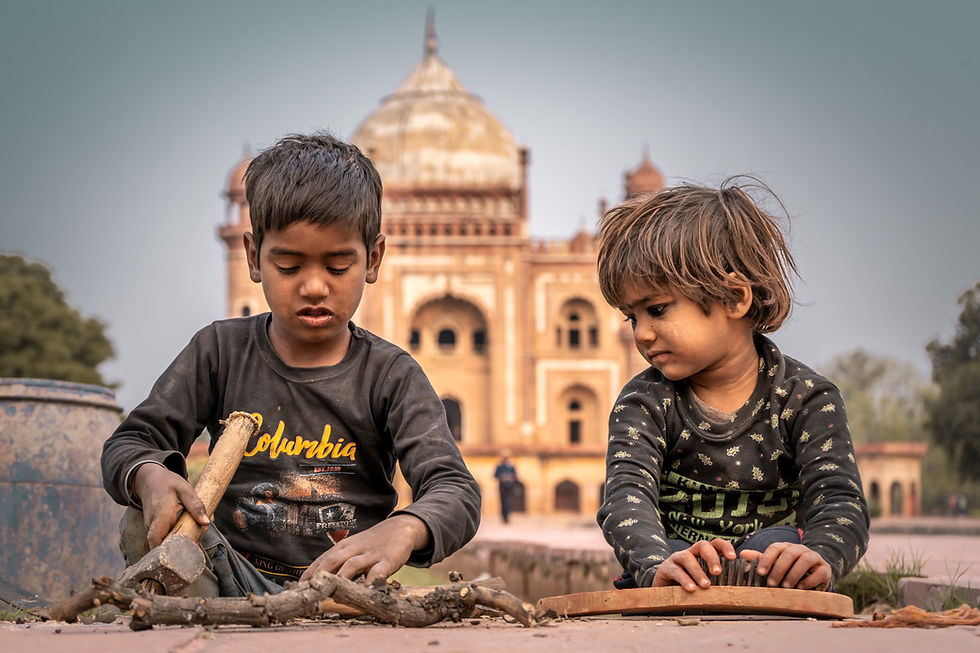Consumerism and Its Impact on Child Labour
- Maisie Freeman
- May 18, 2022
- 3 min read
CW: This article discusses topics of abuse

“The change starts within each one of us, and ends only when all children are free to be children.” – Craig Kielburger
Impact of consumerism
Consumerism is the idea of constantly increasing the consumption of goods and services to buyers. Companies further push their goods through advertising and social media to entice people into buying their products. Consumerism has a number of alarming issues, ranging from environmental, ethical and social; however, it seems as if there is no halt to its growth. With the growth of consumerism, it pushes a growth for more products, more materials, and so more workers to harvest said materials.
It's estimated that over 160 million children still engage in child labour, with the number only rising without the help of mass purchasing throughout the Covid-19 lockdown. In addition to 73 million of said children working in hazardous conditions and 3 million being forced into labour, it's safe to say that child labour is a serious problem. Child labour deprives children of their childhoods, preventing them from having an education whilst also forcing them to endure mentally and physically straining work. The majority of child exploitation takes place in more impoverished countries preying on the poorer families, over 41 countries not protecting children and youth from hazardous work. The majority of children in child labour work in the agricultural sector, this includes farming, hunting and fishing at 70%, and then secondly manufacturing and wholesale and retail being the 2nd biggest sector that children are working for.
Industries
One of the many ingredients being sourced by children includes Mica, being primarily mined in India and China. Mica is a shimmery substance often used in beauty products to add shimmer as well as being used in electronic devices as insulators. Nearly almost every Mica mining has been done illegally; workers, often children, are forced to work in hazardous conditions whilst being harshly underpaid. Children suffer from regular skin irritations as well as respiratory issues such as asthma, silicosis and bronchitis. Every kilo that these children mine, they are given 5 rupees, equivalent to about 5p. The Mica is then sold at market for £750 per kilo, and this is one of the many examples of unfair child labour that are currently happening.
There are many other different fields in which children are being exploited for work, including the Cotton industry, Gold, Coffee, Bricks and Tobacco. The Coffee industry is the 2nd most valuable in the world, only being surpassed by crude oil, at an estimated worth of 93 billion dollars. Coffee farmers often only attain 7-10% of the supermarket price of their coffee, which leads to their children being drafted for work to help support the family. Children as young as 6 will be made to work long 10 hour shift days with very hazardous working conditions; this includes working with harsh pesticides, heavy loads, poisoning and injuries. Some of the highest exports of coffee beans are shown to be guilty of subjecting children to the harshest forms of child labour, only so that we can enjoy our coffee in the morning.
The Tobacco industry also exploits children, even within the US, the work exposes young children to toxic pesticides, which in the long term can lead to cancer, damaged nervous systems, in addition to the impact on reproductive health; which as a child can be more toxic to the body as an adult. Tobacco farms also cause tobacco poisoning, which can lead to nausea, vomiting, dizziness, and many other side effects. The majority of children working on US tobacco farms report symptoms consistent with acute tobacco poisoning. In 2012 two-thirds of children under the age of 18 died from occupational injuries linked to agricultural works on US farms, and 1800 non-fatal injuries occurred across the US.
Ending child labour
So how does one person help towards ending child labour? Firstly ensure that the products you are buying are verified by Fairtrade, this making sure that all workers are treated and paid fairly. This might increase the cost of the product but is needed to ensure less children are being extorted. Buying items second hand or reusing products helps the influx of new items being produced and also helps to get as much use as possible out of items before they are binned.
One could also sign petitions helping the child labour crisis, in addition to donating to different charities which help the cause; here are a small few to get you started. Other ways to support the cause includes getting in touch with different companies and asking about their supply chains; ensuring that each one is being sourced both ethically and environmentally as well as reaching out to different governments to see what their policies are on child labour in addition to other labour laws surrounding the conditions of work.



Comments